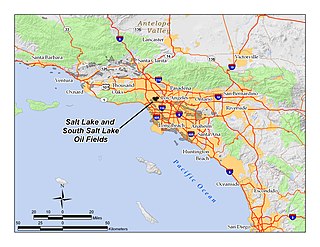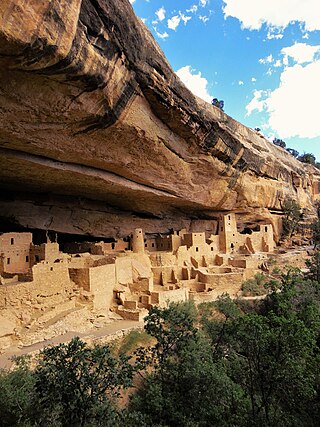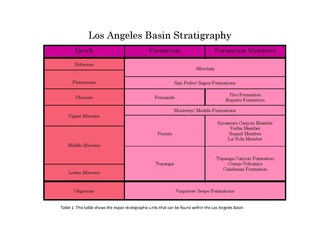
The Los Angeles Basin is a sedimentary basin located in Southern California, in a region known as the Peninsular Ranges. The basin is also connected to an anomalous group of east-west trending chains of mountains collectively known as the Transverse Ranges. The present basin is a coastal lowland area, whose floor is marked by elongate low ridges and groups of hills that is located on the edge of the Pacific Plate. The Los Angeles Basin, along with the Santa Barbara Channel, the Ventura Basin, the San Fernando Valley, and the San Gabriel Basin, lies within the greater Southern California region. The majority of the jurisdictional land area of the city of Los Angeles physically lies within this basin.

Simi Valley is a synclinal valley in Southern California in the United States. It is an enclosed or hidden valley surrounded by mountains and hills. It is connected to the San Fernando Valley to the east by the Santa Susana Pass and the 118 freeway, and in the west the narrows of the Arroyo Simi and the Reagan Freeway connection to Moorpark. The relatively flat bottom of the valley contains soils formed from shales, sandstones, and conglomerates eroded from the surrounding hills of the Santa Susana Mountains to the north, which separate Simi Valley from the Santa Clara River Valley, and the Simi Hills.

The Salt Lake Oil Field is an oil field underneath the city of Los Angeles, California. Discovered in 1902, and developed quickly in the following years, the Salt Lake field was once the most productive in California; over 50 million barrels of oil have been extracted from it, mostly in the first part of the twentieth century, although modest drilling and extraction from the field using an urban "drilling island" resumed in 1962. As of 2009, the only operator on the field was Plains Exploration & Production (PXP). The field is also notable as being the source, by long-term seepage of crude oil to the ground surface along the 6th Street Fault, of the famous La Brea Tar Pits.

The Sespe Formation is a widespread fossiliferous sedimentary geologic unit in southern and south central California in the United States. It is of nonmarine origin, consisting predominantly of sandstones and conglomerates laid down in a riverine, shoreline, and floodplain environment between the upper Eocene Epoch through the lower Miocene. It is often distinctive in appearance, with its sandstones weathering to reddish-brown, maroon, pinkish-gray, tan, and green. Since many of its sandstones are more resistant to erosion than many other regional sedimentary units it often forms dramatic outcrops and ridgelines in many local mountain ranges.

The Ogallala Formation is a Miocene to early Pliocene geologic formation in the central High Plains of the western United States and the location of the Ogallala Aquifer. In Nebraska and South Dakota it is also classified as the Ogallala Group. Notably, it records the North American Land Mammal Ages (NALMAs) Hemphillian, Clarendonian, and Barstovian. It also includes an excellent record of grass seeds and other plant seeds, which can be used for biostratigraphic dating within the formation. The Ogallala Formation outcrops of Lake Meredith National Recreation Area preserve fish fossils. Similar specimens from the same unit are found at Alibates Flint Quarries National Monument in Texas.
The Cherry Canyon Formation is a geologic formation found in the Delaware Basin of southeastern New Mexico and western Texas. It contains fossils characteristic of the Guadalupian Age of the Permian Period.
The Bell Canyon Formation is a geologic formation found in the Delaware Basin of southeastern New Mexico and western Texas. It contains fossils characteristic of the Guadalupian Age of the Permian Period.

The Cliff House Sandstone is a late Campanian stratigraphic unit comprising sandstones in the western United States.
The Fernando Formation is a Plio-Pleistocene marine mudstone, siltstone and sandstone formation in the greater Los Angeles Basin, Ventura Basin, and Santa Monica Mountains, in Los Angeles County of Southern California.
The Fernando Formation is a Pliocene stratigraphic unit in California. Outcrops of the formation in Santa Monica Mountains National Recreation Area have produced fossil shark teeth.
The Drake Bay Formation is a Pliocene stratigraphic unit in California. In 1993, paleontologists excavated a whale skeleton associated with fossil shark teeth and fish vertebrae that may have belonged to a giant salmon from Drake Bay sediments at Point Reyes National Seashore.
The Repetto Formation is a Pliocene epoch sedimentary unit in the greater Los Angeles Basin composed primarily of sandstone and conglomerate.

The Puente Formation is a geologic formation in California. It preserves fossils dating back to the middle to upper Miocene epoch of the Neogene period.
The Hungry Valley Formation is a geologic formation in the San Emigdio Mountains — near Gorman in northeastern Los Angeles County, California.

The Etchegoin Formation is a Pliocene epoch geologic formation in the lower half of the San Joaquin Valley in central California.
The Crowder Formation is a geologic formation in the Central and Western Mojave Desert, in northern Los Angeles County and eastern San Bernardino County, in Southern California.
The Tulare Formation is a Pliocene to Holocene epoch geologic formation in the central and southern San Joaquin Valley of central California.
The Topanga Canyon Formation is a Miocene epoch geologic formation in the Santa Monica Mountains, Simi Hills, Santa Ana Mountains and San Joaquin Hills, in Los Angeles County, Ventura County, and Orange County, southern California. It is primarily composed of hard sandstone with some inter-bedded siltstone.
The Santa Clara Formation is a geologic formation in the southeastern Santa Cruz Mountains, in Santa Clara County, California.
The San Francisquito Formation is a geologic formation located in northern Los Angeles County, California.







